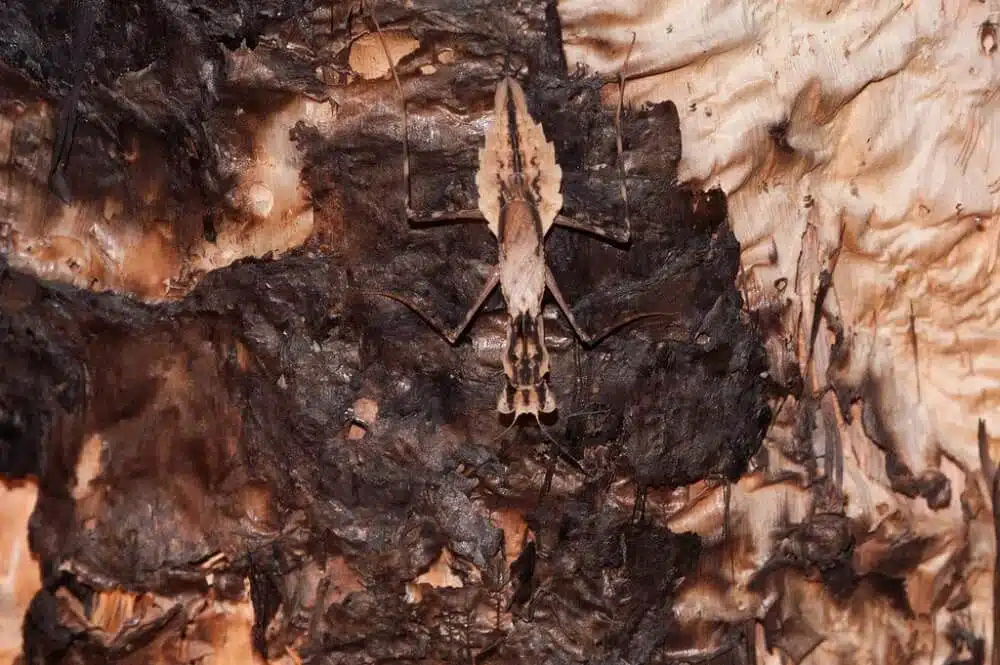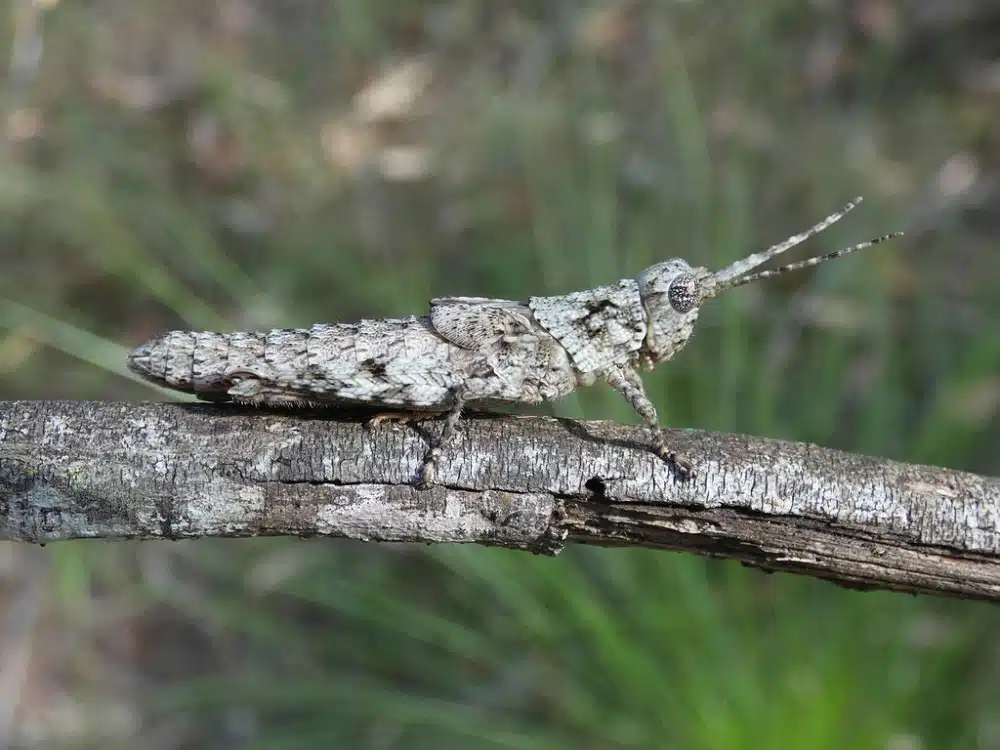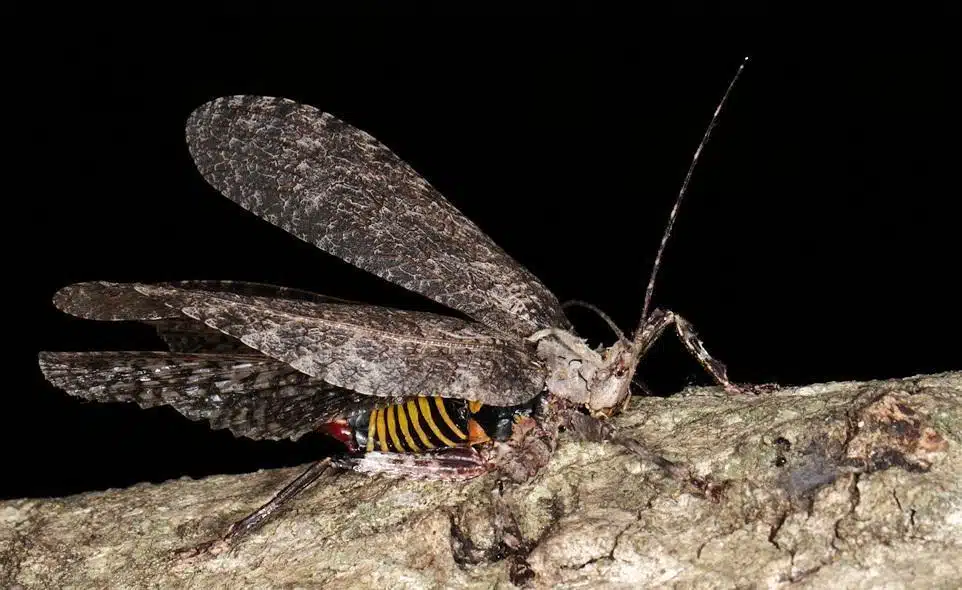Bugs with gray or gray-brown colors that look like tree bark are difficult to spot. All species that mimic tree bark coloring do it as a means to defend themselves in front of predators.
The following species of bugs primarily rely on coloring to keep predators away. They might also have other techniques they use against predatory species but may rely on bark-like coloring for camouflage.
Most of these bugs rest on tree bark during the day, the time they’re most likely to fall victim to predators. It’s here they can blend in perfectly and often get overlooked by predators such as birds and wasps.
Table of Contents
1. Underwing Moths
There are over 200 species of Underwing Moths (genus Catocala), all looking mostly like tree bark. Its subspecies are only differentiated by the coloring of their underwings which can be orange, brown, yellow, white, or red.

The forewings and the body is almost always gray to brown, highly similar to tree bark.
Some of the Underwing Moths of the species have darker forewings and body coloring while others are lighter, closer to gray coloring.
All of them can be overlooked when resting on tree bark. The colorful and contrasting hindwings of the species aren’t visible in a resting wing position.
This species only shows its colorful hindwings when flying or when opening up its wings trying to make predators move along due to their contrasting colors.
2. Common Lytrosis Moth

Eastern and Southern parts of North America are the home to the Common Lytrosis Moth (Lytrosis unitaria). This is a species that takes on brown and gray coloring mimicking tree bark.
These colors are seen all across its forewings, hindwings, and body.
Common Lytrosis Moths are seen in various shades of brown. The upper forewings and the lower hindwings are mostly gray.
A camouflaging species, Common Lytrosis Moths are some of the largest species of moth across North America.
As grown adults, these types of moths may reach a wingspan of up to 50mm.
3. Brown Bark Carpet Moth

One of the species found in North American gardens is the Brown Black Carpet Moth (Horisme intestinata).
This is a species that resembles gray carpet coloring as well as gray tree bark. It has a bark-like color both on the forewings and on the hindwings.
This species may be seen resting on tree bark during the day as a nocturnal species.
A common sight in Eastern North America, this is an invasive species in gardens.
Brown Bark Carpet Moth Caterpillars feed on a few large flowers such as garden clematis.
4. Mourning Cloak

Mourning Cloak butterflies (Nymphalis antiopa) have atypical coloring. They have dark brown dorsal coloring and moth-like bark-mimicking ventral coloring.
Gray, brown, and black colors are seen on its ventral side which mimics tree bark. The margins of the wings are gray to white, mimicking dry wood.
The ventral color of its wings helps the species remain undetected as the butterfly opens its wings in front of potential predators such as owls to blend in with the tree it’s resting on.
A North American native, this butterfly species can also have a very long lifespan which is the main reason it needs to hide from predators all the time.
Many butterflies of the species survive up to a year as they use bark-like coloring to hide in plain sight.
5. Geometer Moth Caterpillars

Some of the most atypical types of caterpillars are Geometer Moth Caterpillars (family Geometridae).
The species uses gray to brown coloring to mimic twigs and the plants they feed on, although they can also come in more vivid colors such as yellow gold.
This is a species that only has front and back prolegs and this dictates how it can move. Its body bends up as it moves forward.
Some people might find the caterpillar stays still in this elevated mid-body position as it tries to look like a part of the plant itself.
Mimicry colors such as bark-like gray also allow this species to be overlooked by predators. Without as many prolegs as other caterpillars, Geometer Moth Caterpillars can only move at a slow pace.
This means they rely on color mimicry techniques to defend themselves as a quick escape is not possible.
6. Bark Crab Spider

Much of the coloring of Bark Crab Spiders (Bassaniana versicolor) is impacted by their natural habitat. A widespread species across woodlands, Black Crab Spiders are among the typical species that partially resemble tree bark coloring.
This species has a gray to black abdomen with patterned coloring which makes it look like tree bark.
Its cephalothorax is mostly black. Bark Crab Spiders have black and bark-like gray coloring as well.
The name of the species is inspired by the positioning of its legs, which resembles the positioning of crab legs.
This species also has a name inspired by tree bark. As an active hunted, the spider often ends up on tree bark where the coloring acts to its camouflaging advantage.
This species ambushes and pounces on prey as it doesn’t spin spider webs to catch insects.
7. Bark Praying Mantis

Bark Praying Mantises are groups of mantis bugs that rely on color mimicry techniques to avoid predators.
They come in different colors which mimic tree bark coloring and even tree bark with green lichen.
For example, the Spiny Praying Mantis (Gyromantis kraussi) is a species that has gray-brown coloring mimicking loose tree bark.
This species has a flattened body to make it even less visible on trees, much like most other Bark Praying Mantis bugs.
Boxer Bark Mantises (Paraoxypilus) is a gray bark mantis that also uses its body shape to mimic ants.
Reduced size and color that resembles gray and white tree bark make this Oceania mantis bug escape predators.
Ground Mantises in the Tarachodes family are among the few bark-mimicking Bark Praying Mantis that don’t have a flattened or highly sculpted body.
This is a species with an elongated round body that only shows gray bark-like coloring.
8. Common Adreppus

This species of grasshopper (Adreppus fallax) has a base brown color with gray nuances which makes it resemble tree bark.
Its wings are closer to brown in color while its body, legs, and antennae are closer to gray in color.
This is a species that’s only native to Australia and which has its colors adapted to local ecosystems where brown is prevalent.
The species is also seen in a gray and black morph, especially in dense vegetation habitats.
Both the coloring and the motionless daytime nature of the species make it hard to detect.
Resting on trees, the Common Adreppus bug always chooses the side of the tree most similar to its coloring so that it’s overlooked by predators.
Bugs of this species which have multiple black spots have even been seen on Australia’s multiple trees that have partially burned in the multiple wildlife summertime fires.
9. Arizona Bark Scorpion

The Arizona Bark Scorpion (Centruroides sculpturatus) is one of the most venomous scorpions in North America.
This species spends much of its time on wood and the dry arid land of Arizona. This inspires its brown or tan colors most scorpions of the species are seen in.
This species can also be identified by its small size, apart from its distinct coloring. It grows up to a size of 2.7 inches.
Since it’s a nocturnal predator, this scorpion relies on its brown colors to hide during the day. They also seek out tree bark or logs to hide under during the day.
The species is highly venomous and the symptoms of its bite may be severe. You may vomit up to a few days after being stung by this species.
Medical attention is required and those bitten might be given an antivenom.
While deaths following the Arizona Bark Scorpion sting are rare, there are at least 2 known cases over the past 5 decades to worry about.
10. Common Bark Katydid

These types of bush crickets (Cymatomera denticollis) come in multiple colors but their wings mimic the coloring of tree bark.
Gray to brown wings covers the body of the species completely. Since the wings of the species are longer than its body, its colorful black and yellow body aren’t seen when its wings sit in a resting position.
When resting on trees, this type of katydid is rarely spotted by predators.
Even its legs have gray and brown coloring, similar to the coloring of tree bark.
11. Brown Marmorated Stink Bug

Brown Marmorated Stink Bugs (Halyomorpha halys) are some of the most predated species in North America.
This shield-shaped bug is often the many preys for various species of wasps. It can also be eaten by birds and small reptiles.
Brown Marmorated Stink Bugs rely on coloring and smell to escape predation as well as on flying.
This species has a dark gray to brown color which mimics tree bark and which makes the species difficult to spot when resting on trees or in dense vegetation.
Bugs of this species may attempt to release a foul smell whenever captured by predators in the last escape attempt.